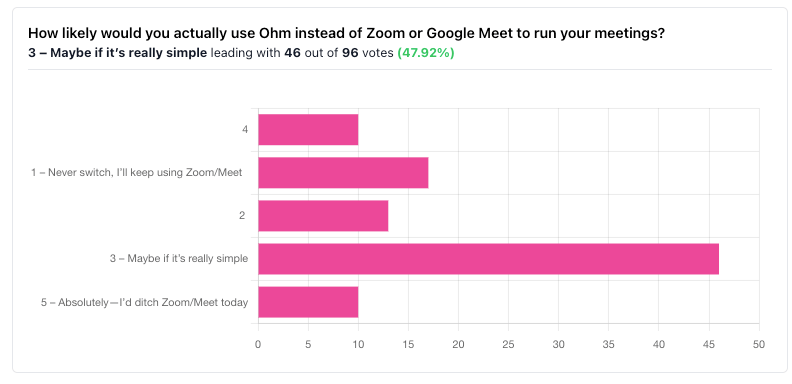Not subscribed? Sign up to get it in your inbox every week.
"So you built... another meeting platform?"
That's what our first design partner said after sitting through our demo.
Not exactly the reaction we were hoping for after two weeks of building what we thought was revolutionary meeting software.
We'd created real-time transcription, AI summaries, and instant context searching.
But watching four different operators politely nod through our demos made one thing clear: We were scratching the surface of a much deeper problem.
🚦 The Hidden Cost of Recurring Meetings
Here's the embarrassing part: After weeks of building what we thought was meeting software, I realized we'd never actually analyzed my own workflow as a COO who ran 10 one-on-ones, 4 team standups, and 1 executive meeting every week.
When I finally sat down with Paras (our technical co-founder) to walk through my process, something clicked: For every 1-hour meeting on my calendar, I was spending 2 more hours on the invisible work around it.
The real tax wasn't the meeting itself. It was everything else:
The Sunday night anxiety of preparing for 15 different conversations.
The constant fear of missing a crucial update because I was managing managers, not doing the work directly.
The psychological weight of knowing I needed to call someone out for missed deadlines, but first having to hunt through docs and Slack threads to build my case.
As a skip-level manager, I couldn't just dive in and fix things myself.
I had to orchestrate conversations, track commitments, and somehow maintain ground truth across layers of management - all while trying to be strategic instead of drowning in meeting admin.
💡 The Breakthrough
That conversation with Paras changed everything about what we're building.
While most meeting tools focus on the 60 minutes you're in the call, we realized we needed to solve for the invisible hours spent preparing, following up, and managing psychological overhead.
Organizational researcher Rob Cross found that collaborative demands on time—meetings, reviews, gut-checks—have increased more than 50 percent in the past two decades. And it's gotten worse since the pandemic.
But it's not just about more meetings. It's about the compounding fatigue of:
Preparing to look competent when you're three management layers away from the details
Hunting down status updates from people who'd rather avoid you
Trying to focus on strategy while playing meeting police
🟢 The Solution Taking Shape
Last week showed us what's possible. Instead of spending the first ten minutes of a 1:1 reconstructing context from old docs and Slack threads, a teammate and I jumped straight into problem-solving.
The prep work, status tracking, and follow-ups were just... handled.
That's what we're actually building - a way for managers to stop playing archaeologist with their past conversations and start leading.
📝 The Market Reality Check
We ran a poll in the newsletter. Here's what you all said:
47.9%: "Maybe—IF it's really simple."
Plenty said, "Never, I'm sticking with Zoom/Meet."
A brave handful: "Ditch Zoom/Meet today, sign me up."

Best feedback? "Pricing and confidentiality will be a factor," and "Getting people to use a third system is hard."
🔥 What We Know Now
Real-time chat is cool, but autogenerated to-dos and "meeting memory" are what's blowing people's minds
Ops workflows are scattered across docs, Slack, and people's brains. Nobody has a single source of truth for action and context
The big bet: If Ohm combines video, notes, tasks, and AI into one seamless flow, teams might finally ditch their duct-tape solutions
👀 What We're Still Wrestling With
Positioning: How do we communicate that this isn't just another meeting tool?
Pricing: Most people get video "free" with Google/Zoom, so Ohm has to deliver undeniable value. Working on making it a no-brainer
Serving power users vs. everyone: How do we help the ops nerd and the person who just wants reminders?
📊 What's Next
We're focused on three things:
Making the before/after meeting flow 10x simpler
Building dead-simple integrations so you can try Ohm without disrupting your current stack
Running "before and after" trials to measure exactly how much time and sanity we're saving teams
❓ Help Us Figure Out What to Tackle Next
Reply with the number for what you want us to dive into:
How we are thinking of positioning the product?
What’s the pricing model for something like this?
Failed attempts by others
Reply or DM if you want to be an early tester or just roast our product direction. We're learning in public—and the more honest your feedback, the better Ohm gets.
Stay out of calendar hell,
Rameel

